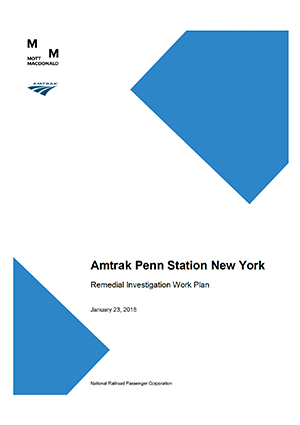
New York Penn Station
New York Penn Station
Site Location
New York, NY
Contact Us
If you have questions or comments on the restoration plans for these sites, contact AskEnvironmental@Amtrak.com.
Since 2016, Amtrak has been implementing interim environmental restoration actions following the identification of sediment impacted by polychlorinated biphenyls (PCBs) on track surfaces at Penn Station New York (NYP). NYP was impacted by PCB-containing transformer oils from historic rail operations. Future environmental restoration actions at NYP will be managed by Amtrak and are anticipated to include excavation and offsite disposal of contaminated track material under a risk-based restoration approach following the completion of a Remedial Investigation and Risk Assessment.
NYP was constructed between 1901 and 1910 by a predecessor of the Pennsylvania Central Transportation Company (Penn Central). The original station was a vast structure that occupied two city blocks. It was one of the first rail terminals to separate arriving from departing passengers on two concourses. The existing station layout above the passenger platforms and tracks was constructed in the late 1960s when portions of the structure were razed for the construction of Penn Plaza and Madison Square Garden. Ownership of NYP, which was part of railroad operations providing passenger rail service on the Northeast Corridor, was transferred from Penn Central to Amtrak in April 1976 under the Regional Rail Reorganization Act of 1973.
Currently, NYP is comprised of three main levels all situated below street level: Upper Concourse, Lower Concourse and Platform/Track. The Upper Concourse contains waiting areas for passengers, ticket services, vendor areas and access to the platforms via stairs, escalators and elevators. The Lower Concourse provides access to the platforms and provides additional waiting areas and vendor services. The Platform/Track Level consists of the area of the station where platforms provide access for passengers to board trains for 21 tracks. Additionally, this level contains electrical substations and other areas occupied by Amtrak workers (e.g., break room, locker room, etc.).
Passenger rail services at NYP are provided by Amtrak, New Jersey Transit (NJT) and the Long Island Railroad (LIRR). NJT uses Tracks 1 through 4, Amtrak and NJT share Tracks 5 through 14 and LIRR uses Tracks 15 through 21. Operating 24 hours a day, 365 days a year, NYP is the busiest passenger transportation facility in North America. Each of the station's 21 tracks are in use every 2 minutes, on average, during weekdays. NYP serves more than 630,000 passengers on 1,345 trains per day.
Site Location Map

In April 2016, during an engineering maintenance project, PCBs were detected in sediments that had accumulated on the concrete track structure on the Platform/Track Level. The concrete track structures themselves are located approximately 50 feet below the street level and 4 feet below the platforms. Upon discovery, the findings were reported to the EPA and New York State Department of Environmental Conservation (NYSDEC) in April of 2016. Amtrak promptly began, in consultation with the EPA and NYSDEC, the process of investigating the scope and extent of PCBs at NYP. Amtrak took immediate action to limit potential PCB exposure to site workers, which included issuing worker advisories, providing personnel protective equipment to employees working at the site, as well as other protective measures. Amtrak also informed the other railroads using NYP of the situation. Additional analytical testing revealed the presence of PCBs throughout much of the track infrastructure. Subsequent analytical sampling and testing also revealed the presence of PCBs in dust that had accumulated on light fixtures and conduits above the platforms.
Following this identification of PCBs, Amtrak initiated interim restoration actions to remove these materials from the concrete track structure and dust throughout the platform level. Real-time air monitoring and dust control measures were performed to monitor and document airborne particulate levels during track cleaning and dust removal activities for human health protection. Track cleaning consisted of the removal of sediment and “tar-like” material followed by track washing performed from April 2016 to April 2019. A total of 14,841 linear feet of mounted concrete track surfaces at Tracks 1 through 18 were cleaned (including the column line). Waste generated as part of these interim restoration actions (including but not limited to sediment, concrete, ballast, dust, and personal protective equipment) has been disposed of as a Toxic Substances Control Act (TSCA) regulated waste. Throughout the course of this work, Amtrak has provided detailed monthly updates to EPA and NYSDEC about its PCB cleanup activities.
Concurrent with the track cleaning efforts, Amtrak developed a Remedial Investigation Work Plan (RIWP) for EPA review and comment. The RIWP was finalized in 2018. Since 2018, Amtrak has been collecting the required samples and analytical data to support a risk-based restoration approach for NYP. The current schedule includes submitting a Remedial Investigation Report/Risk Assessment (RI/RA) report to EPA by the end of 2024. The RI/RA will also be made available for public comment. The restoration goal is to remove PCB-impacted soil, sediment and concrete to meet the risk-based target that will need to be approved by EPA in accordance with 40 CFR § 761.61(c).
Amtrak Guest Rewards
Forgot Password?
Passwords are case sensitive, should be at least 10 characters long and should include 1 uppercase and 1 lowercase alpha character, 1 number and 1 special character. ! " # $ % & ' ( ) * + , - . / : ; < = > ? @ [ \ ] ^ _ ` < | > ~
Enter the email address or member number associated with your account. We will send password reset instructions.
An email with password reset instructions is on the way.
That answer wasn’t correct either. We’ve sent you an email with instructions to reset your password instead.
